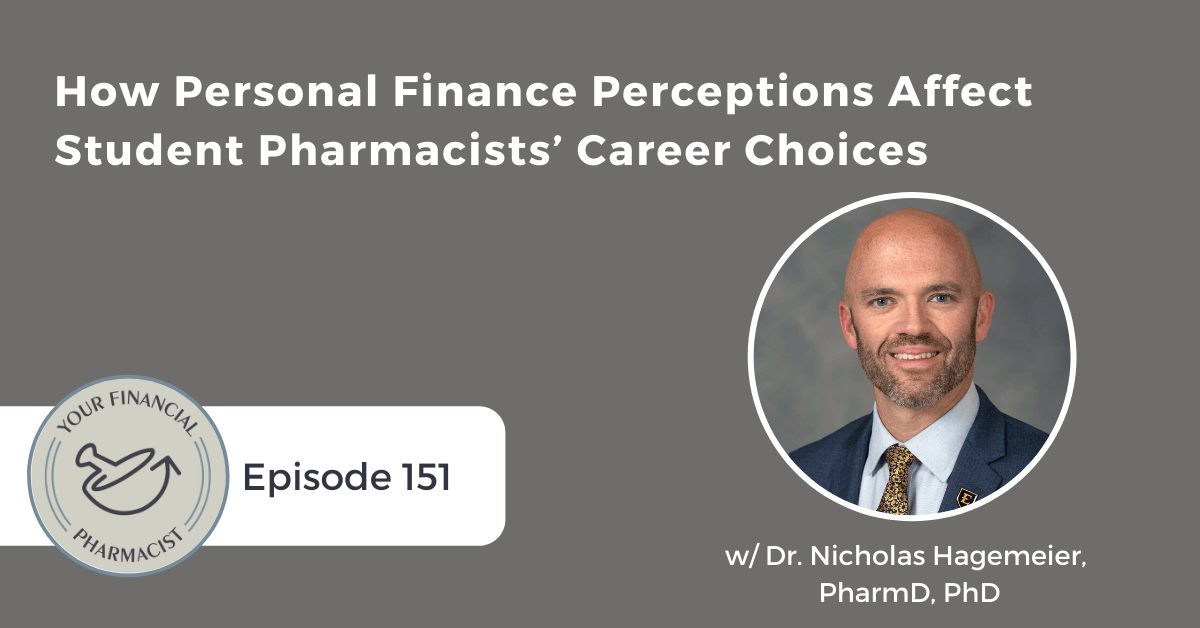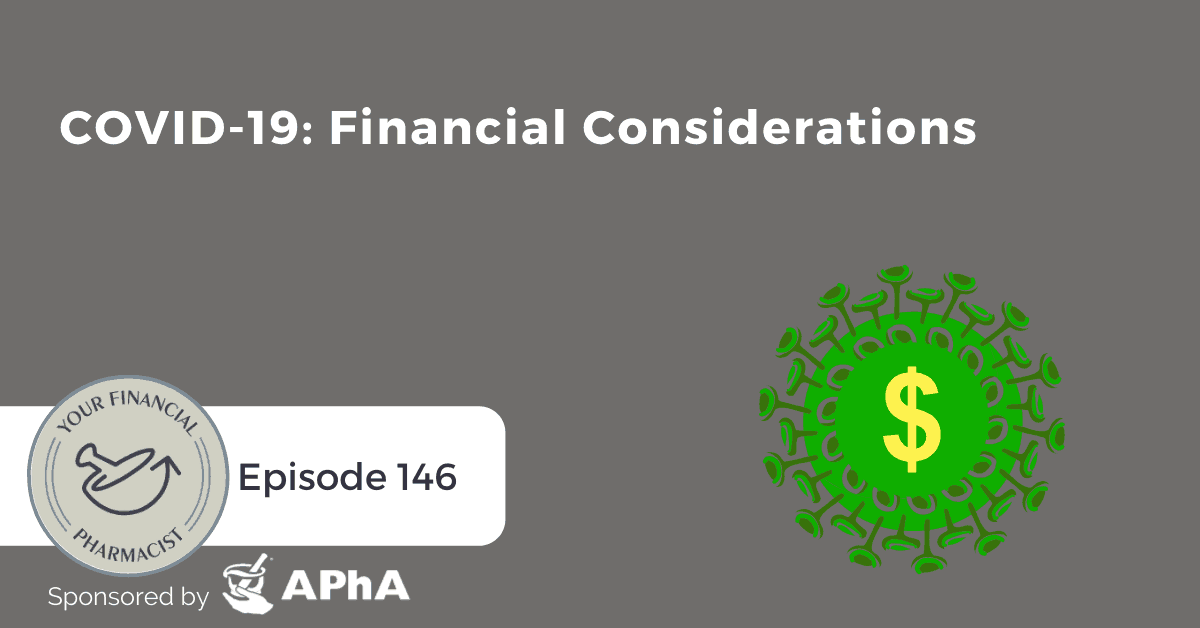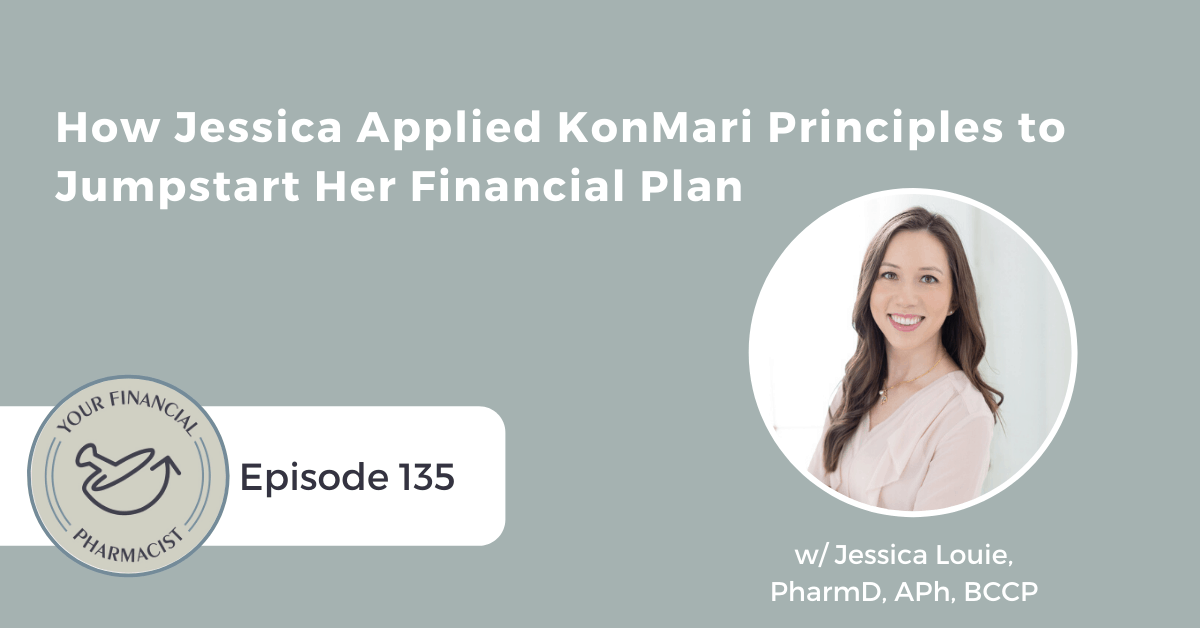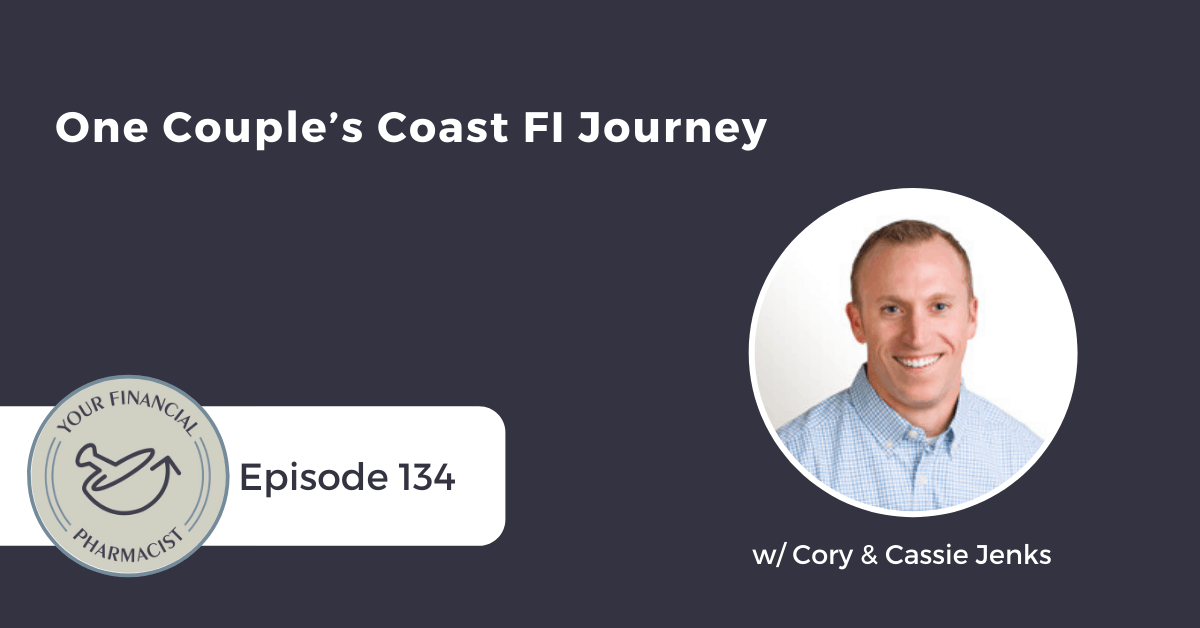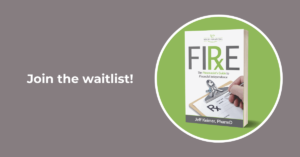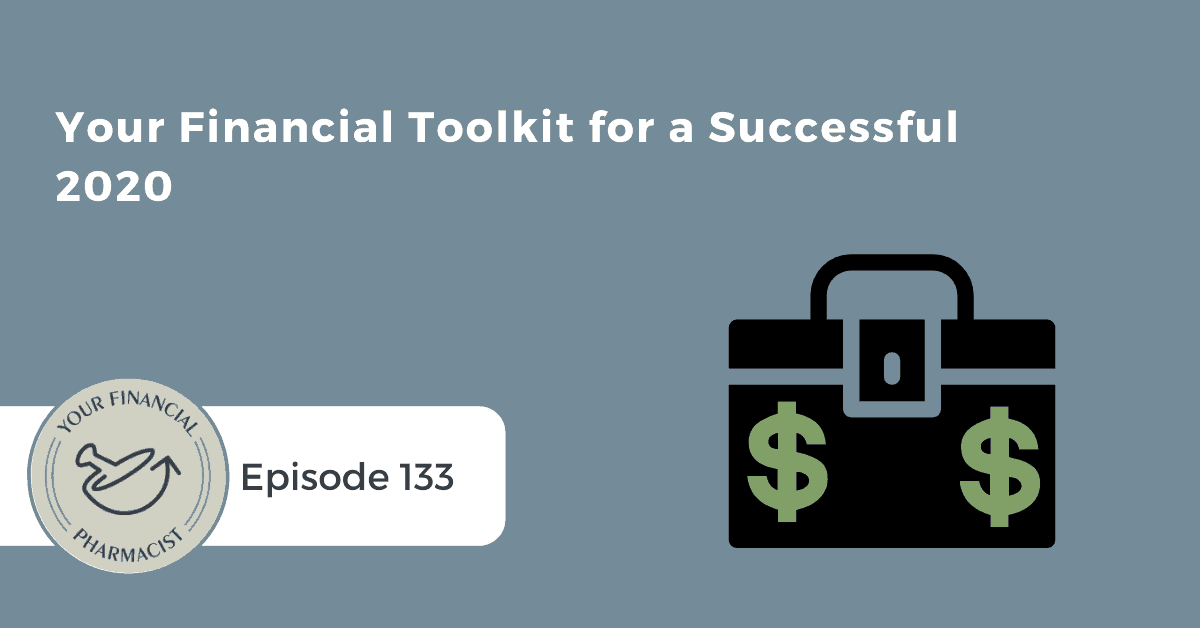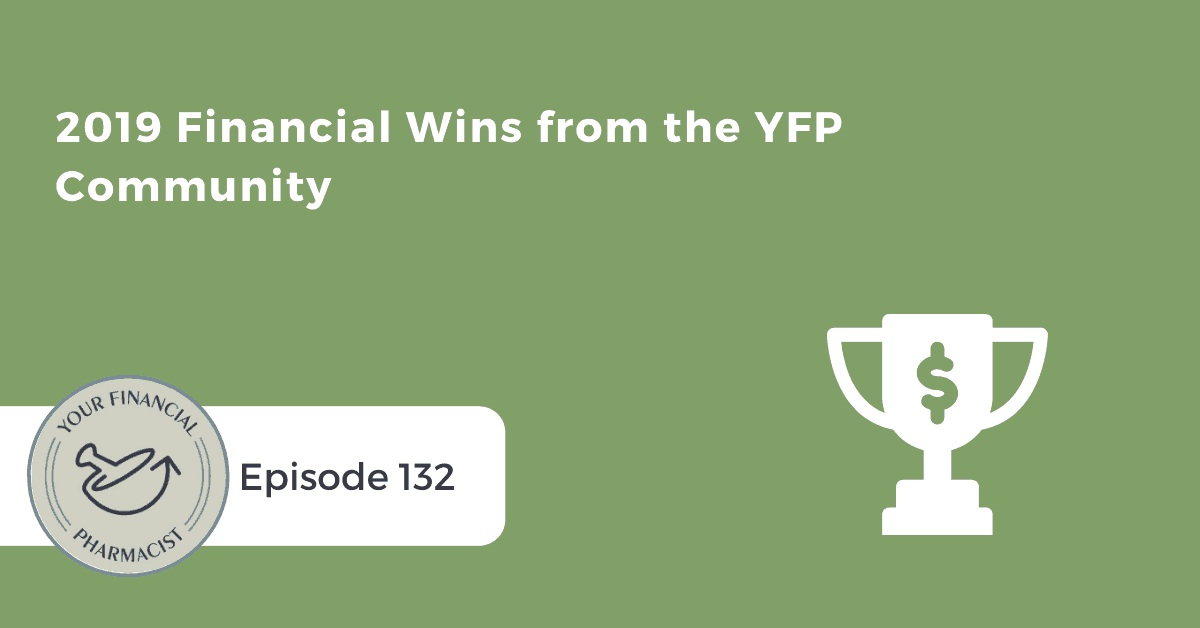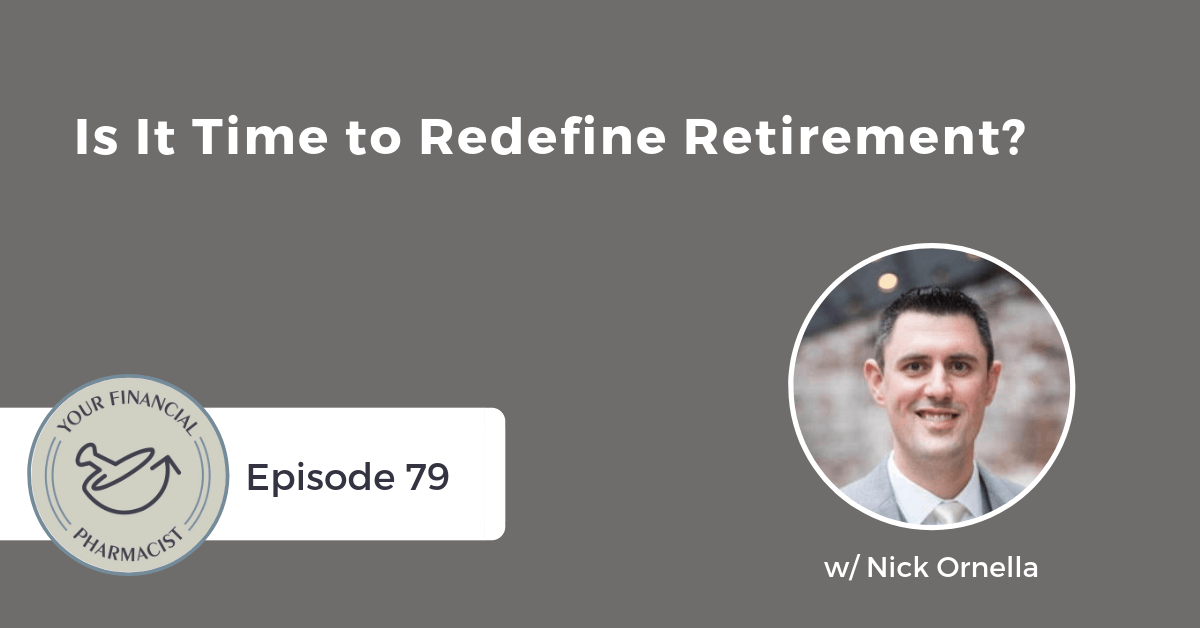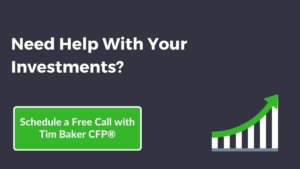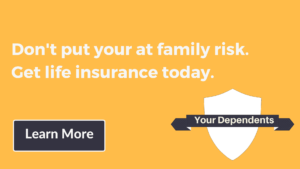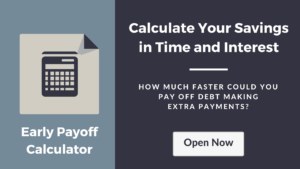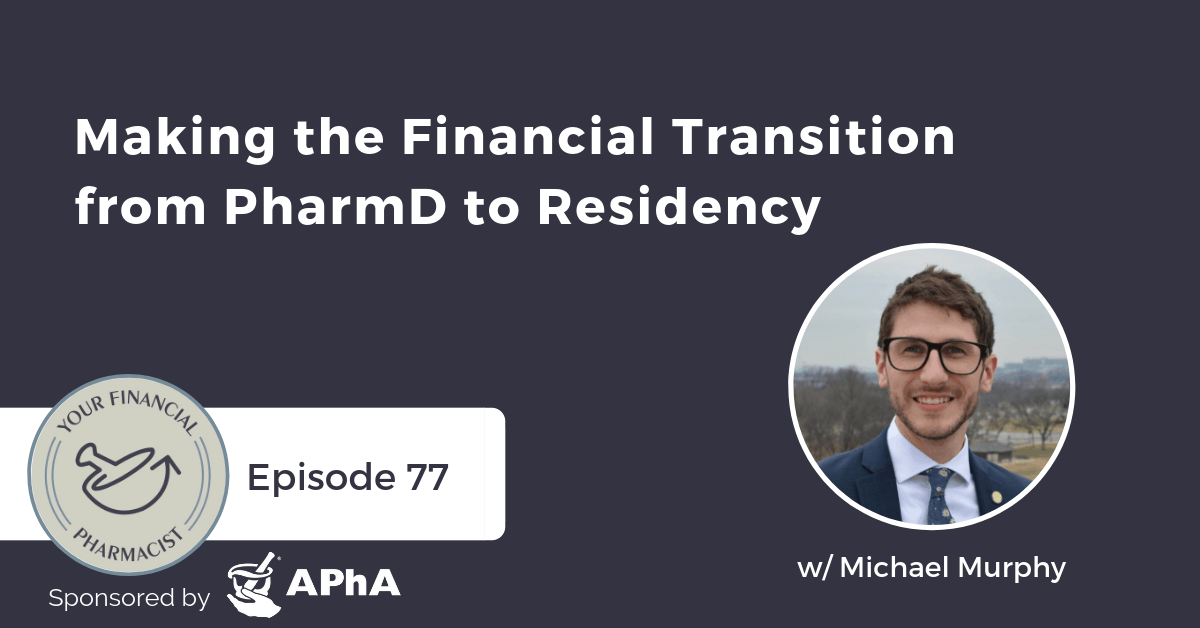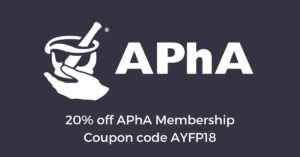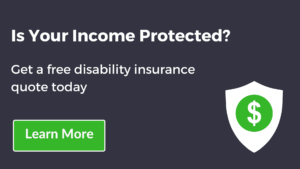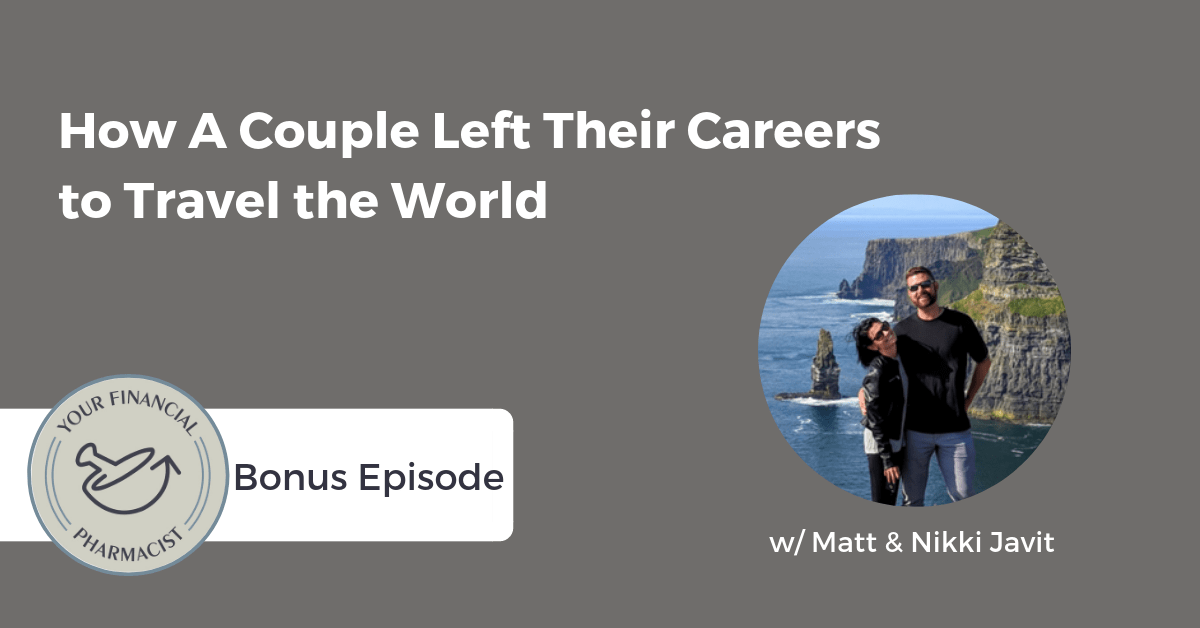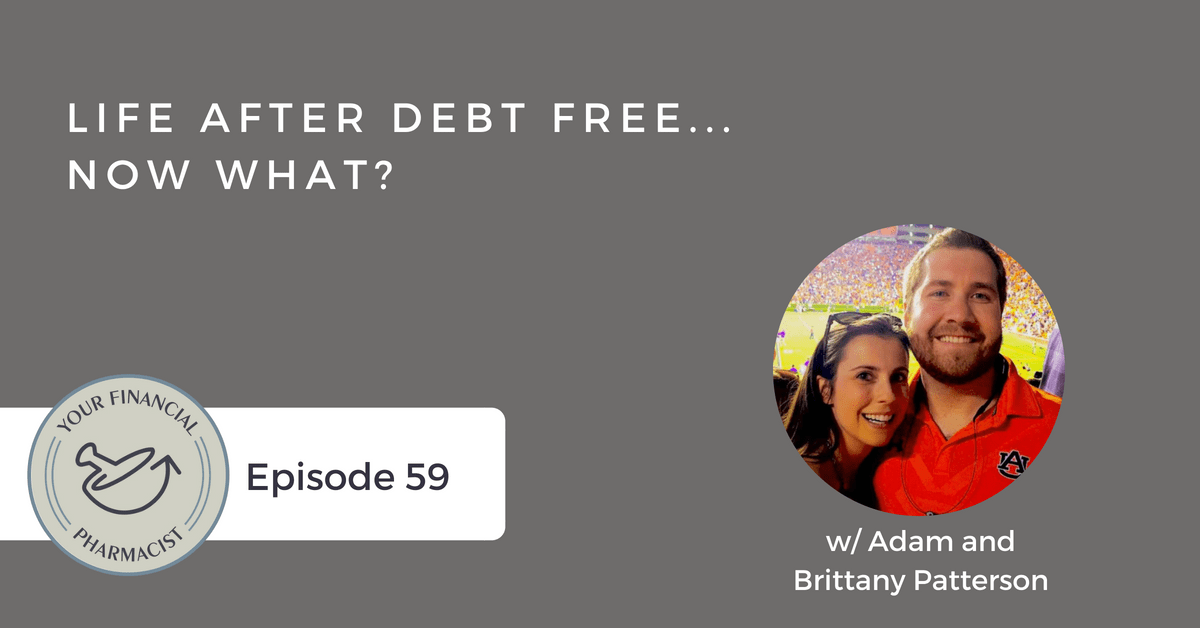COVID-19: Financial Considerations
Things are changing on a daily basis secondary to COVID-19. In these unprecedented times, there are a lot of financial concerns people are likely having. On this episode sponsored by APhA, Tim Baker, CFP® answers questions about investing, the uncertainty of work and student loans.
Summary
This podcast is from the APhA and YFP webinar recorded on March 31, 2020. In the past couple of weeks, so much has changed as a result of COVID-19. Between the stock market being down, unemployment rising, the CARES Act and rapid changes with federal student loans, it’s likely that you have a lot of questions regarding your finances.
During this discussion, Tim Baker, CFP® answers the questions everyone has at the top of their mind and focuses on the topics of investments, uncertainty of work and student loans. He also dives into the CARES Act and the levers you can pull if you’re facing financial hardship due to unemployment or a reduction in hours.
Mentioned on the Show
Episode Transcript
Tim Ulbrich: Well, good evening and welcome to this webinar. My name is Tim Ulbrich from the team over at Your Financial Pharmacist, and I’m excited to also have joining me my partner in crime and Certified Financial Planner Tim Baker as we’re going to talk about a big-time topic right now, which is financial considerations and COVID-19. So thank you so much for taking time out of your schedule to be here tonight. Thank you for those that during the registration process, you submitted questions and concerns that you have. That really helped us shape how we’ll spend our time this evening. And we’re also going to have time to take your questions throughout the evening as well. So thank you again. And first and foremost, before we jump in to individual topics, I know many listening or perhaps those that couldn’t be here tonight that will watch the replay are on the frontlines of this, putting themselves at risk and obviously stress that comes along with that and carrying that risk back home. So thank you so much for the work that you’re doing for the patients that you’re serving. And we certainly appreciate that effort.
So so many financial issues that are swirling around a time like this. And we’re going to try to hit some of the major ones, certainly not all of them knowing there’s so much changing so quickly, literally some days it seems like by the hour. At least by the day, we have some piece of news that’s coming out as it relates to COVID-19 and something related to the financial plan. If we look at just the past couple weeks as an example, we’ve seen the markets really take a significant hit. As of this morning, the Dow Jones was down roughly 25% from its February peak. And we actually saw that was inching closer to 40% last week before we saw an increase at the end of last week. Unemployment rate predictions are upwards of 30%. We certainly hope that many pharmacists aren’t going to be in that figure, but we’ve already seen a significant rise in unemployment claims in this area. We saw news of the fed cutting interest rates. And in one week, we had three pieces of big news related to student loans. First, the announcement from the Trump administration that we would be freezing interest rates on student loans for 60 days. Then, the announcement that there would be a pause of payments due for a 60-day period. And then of course, with the stimulus package that was passed last Friday, ultimately as we’ll talk about in more detail tonight, six-month window on most federal loans in terms of pausing the payments as well as interest accrual during that time. So certainly big news here in the last couple weeks as it relates to student loans.
So lots of things to talk about, and a brief introduction to the format. Then we’ll jump right in, and I’m going to put Tim Baker on the hot seat and start firing away your questions as we talk about really three big buckets of topics that we saw come through as themes when you all registered for this webinar this evening. One was around investments, you know, what do I do in terms of my investments during an uncertain time period such as this? How does my investing strategy change? So we’ll talk about that in detail. The second around the uncertainty of work and what this time period means in terms of employment and changes and we know some of you may be dealing with this more for others. And how does that impact the financial plan? And what could you be doing during this time of uncertainty? And then last of course would be student loans. And as I mentioned earlier, there’s a lot, a lot to talk about here. So in terms of the format, what we’re going to do is I have gathered some questions in advance, and I’m going to fire away at Tim Baker in each one of these three areas: investments, work uncertainty, and student loans. And then we’ll pause at the end of each of those sections to answer some of your questions. We may not get to all of them, but we’ll try to get to as many as we possibly can this evening. So if you have a question as you’re hearing some of the discussion this evening, please go ahead and submit that in the chat, and then I’m going to ask Drew from APhA, who’s on the call this evening, to help us field those questions and we’ll take a couple breaks throughout.
I do want to thank before we get started as well the American Pharmacists Association for the continued partnership that we have with Your Financial Pharmacist to provide financial education resources that are exclusive to APhA members. So this is one example, but we’ve been doing webinars often and live events. We have discounts on our products and services, including comprehensive financial planning, which you can learn more about at YFPPlanning.com. So to check out a lot of the resources that we’ve done with APhA, you can go to pharmacists.com/YFP and get more information about that partnership and even go back and watch some of the webinars that we’ve done over the past couple years.
Alright, Tim Baker, officially welcome. That was a long introduction, but welcome.
Tim Baker: Yeah.
Tim Ulbrich: And I know this is a chaotic time, so thank you for taking time out of your schedule to do this.
Tim Baker: Yeah, of course. Happy to be here.
Tim Ulbrich: So we know that many of your clients at Your Financial Pharmacist certainly are having a lot of questions. So many of these you probably already have gotten, but we’re going to go through, as I mentioned, each of these in more detail in three different buckets. So let’s start with investments. And I think probably the most common question that we’re seeing in a time period such as this, which is really similar — while the situation is different — similar market drops to what we saw in 2008 is what should I be doing as I think about my account being down? So the question here is my accounts are down 25% — so assuming your retirement accounts — from mid-February. How should my investing strategy change during this uncertain time where it appears there’s no end in sight to this pandemic and the havoc that it’s wreaking? So talk to us about investment strategy broadly during a time period like this.
Tim Baker: Yeah, so — again, if people have heard me answer these questions, I’m going to start off with the worst answer ever. It’s going to depend. So a lot of our listeners are 20-something, 30-something, 40-something year-olds. And if your portfolio goes down now and you’re planning to retire when you’re 50, 60, 70, it doesn’t matter that much. Now, I don’t want to be facetious in saying that because it’s still painful when you look at hey, I had $200,000 in my portfolio and now I have $160,000 or something to that effect. That’s never fun, and we as human, those losses that we feel, the loss aversion really takes hold of us and it’s not fun. But the fact of the matter is that in most cases, these types of corrections, which last time was a subprime mortgage crisis that was created by kind of poor lending practices, this is a pandemic. I thought we were going to have kind of a downturn in the market due to an election. But this is kind of something that’s come out of nowhere, in essence, that’s really affected the market. And typically, these types of things, they last in the long run three years, three and a half years. So again, if you’re — I’m 37. I’ll use my example. If I’m going to work until I’m 67, that’s 30 years. I’m probably not going to even remember this unless I think about all of the Netflix I watched or the Zoom conferences that I had with my family, the games that we played. So now, the equation is a little bit different if you are kind of further along and closer to retirement. So probably some of the worst years to take a recession or to take a hit in your portfolio is right as you’re about to retire. So you know, 2, 3, 4, 5 years out. And the reason for that is when you start withdrawing on your portfolio in retirement, now you’re taking principal out, and you have to make up those gains that much more. So going through the eye of the storm in retirement is kind of like the couple years out to a couple years into retirement, which is when you probably want to be the most conservative. So depending on what side of the coin you’re on, that’s going to be a big part of it. Now, I was talking with a counterpart that said, hey, a bunch of his clients are reaching out and they’re like, how am I doing? And most of his clients are OK because he’s built out basically a bond ladder to get them through recession-like downturns in the market. So they’re basically priming that and maybe a little bit too much for this particular talk, but it really depends on where you’re at. So I would say as a general principle, a general rule of thumb with investments, you typically want to do the opposite of how you feel. So you know, when the subprime mortgage crisis was going on or right before the subprime mortgage crisis, people were taking out money from everywhere to buy real estate. When the dot-com crisis happened, right at the peak of that, people were taking out second mortgages on their house to buy cats.com. So in that case, we know that the markets probably inflated, and we want to be a little bit more conservative. I’m not saying do anything vastly different, but in the downturn, you know, when we see that slight, that drawdown, we typically want to take our investment ball and go home. So that’s what I tell my clients is that you don’t want to take your investment ball and go home. You actually want to do the opposite. You want to keep playing. If you can, you want to play some more, which means that if you are in a good cash position, get money to the market. Now, I often — and I said this last time we talked about this — sometimes I think financial advisors or we as humans, we rationalize away the loss and we’ll say, oh, it’s a great time to buy. It is kind of because when Trump was elected last time, I’m like, oh, the market, it’s overpriced, we’re going to see a correction, not a great time to buy. And that’s kind of the levels we’re at now. So it’s relative, right? But to me, the rule of thumb here is typically the more that you do, the worse. The more tinkering, the more you try to like outfool, outplay the market, it’s not going to work. You know, best rule of thumb is if you’re kind of in this situation where you’re in this accumulation phase, if you can invest more, invest more. If you can be a little bit more aggressive, be a little bit more aggressive. I often say that if you’re kind of in your 20s, 30s and 40s, you probably shouldn’t have any bonds in your portfolio at all. That’s my belief just because basically they’re a drag on your investments. When you get closer to retirement and there’s more safety in principal, then you want to put bonds in there and start really building out kind of that retirement paycheck, that bond ladder. So lots of words, lot of different ways to look at that. At the end of the day, this too shall pass. Markets will go up, it’s part of the general cycle of things. We’re basically being forced into this one a little bit more because of the pandemic, but we were also on an 11-year bull market, a positive market, really since the last downturn. So yeah.
Tim Ulbrich: Yeah, great stuff. And Tim, this really has been a reminder for me in a couple areas. It’s something we preach and teach, but when it hits you directly, it’s a gut check to say, do I really believe in what I preach and teach? And you know, we talk about volatility and the irrationality of the markets and who can predict it, what a great example this has been. I mean, nobody can say they — now, some people might say I saw a bubble and it was eventually going to pop, yadda yadda yadda ya, but nobody predicted COVID-19 specifically. Maybe Bill Gates. But nobody predicted the impact that that would have at this time period and obviously the unemployment, all the impacts we’ve had. But also I think it’s just been a good reminder of some of the investing principles and strategies that I know I’m highly leveraged in stocks, you see a significant drop, I log into my accounts, I want to take action. I know I shouldn’t take action, so for me, this has also been a really good reminder of the value of having a coach in your corner, on your team, in a time period like this to really help you take a step back and look at the whole plan and to really go back and think, what’s the goal? What are we trying to do? What’s the timeline? And a period like this quickly becomes very emotional, not objective, and I think having somebody else that can really help you navigate a difficult time like this is a great reminder.
Tim Baker: Yeah, and my overall belief — I have a few of them — but my overall belief for investments is that investments should be as boring and budgeting. It should be as boring as paying off the debt. It should not be sexy, it shouldn’t be exciting. I think oftentimes when we make it that, that’s where we get into trouble because we’re typically going into investments that maybe cost too much. So when you think about like, oh, this is a smart beta fund, it’s going to cost the investor a lot of money. You know, even I am like, oh man, maybe I should buy this stock because it’s trading really low. And the example I gave the last time we talked about this is you know, when we had corrections in the ‘80s and ‘90s, my first employer out of the Army was Sears. Sears was this giant company that was never going to go away, it was retail supreme, kind of like the Amazon of today. It’s trading at like $.31 a share right now because they just were — so everyone thinks well maybe Amazon — I don’t think Amazon shares are down — but maybe that other, that Walmart or that other stock. So you start twisting your mustache to say hey, maybe I can outsmart the market, maybe this is a great time to buy. And my belief — and again, I do this for a living — is I just become overwhelmingly humbled again and again by that. So you can — I think it’s OK, my personal opinion, to take a small percent, 5-10%, and speculate on stocks. I don’t personally do it anymore because I, again, I’m tired of being humbled by the market. I like to buy the market. It treats you right over the long term and just rebalance it over time. So one of the things that I think you can do if you’re up for it is that if you’re not in something like a target date fund, you know, when I’m reviewing — I reviewed a client’s patient, actually one of the clients are about to be forgiven for PSLF. They’re two months away. Yeah, one of the things that we looked at their TSP and the spouse’s 401k, very out of balance in terms of like their equity to fixed income ratio. So one of the things we were going to go do — and we can do this for them with some of the tools that we have — is we basically rebalance that back because right now their portfolio is more conservative than what they signed up because equities are depressed and as a result, the fixed income makes up a bigger percentage. So we’re basically going to rebalance those out. Now, my counsel to them is get rid of the bonds in general. They’re about my age, a little bit older. But they’re kind of in a 90-10 stocks to bonds split. So that’s maybe one thing that you can do to tinker or change. And in reality, you should do that once or twice per year. And I think that’s good.
Tim Ulbrich: Yeah, and I think that’s a good reminder. I haven’t seen a lot of discussion on in this area of investing is making sure you’re looking at your distributions and rebalancing appropriately as a time period like this can certainly throw things off. So to your comment, you alluded to this, and I’d like to talk more about this. Question here is for several people that are listening that may be in a position to invest, you know, they might look at a time like this and say, “OK, is this a time I should be doubling down? Should I do it? Should I wait? Should I hold that money for other uses, depending on a certain time? Where do I begin to think about how to invest that money?” So talk us through more of the opportunistic side of if I have money to invest, is this a period where I want to make that move?
Tim Baker: Yeah. And again, it depends, Tim, again. I’ll say that again and again. You know, if we look at your balance sheet and you have that emergency fund that’s fully plussed up, your consumer debt is in line so you’re not really — you don’t have any credit card debt or you’re not paying that couch off that you bought a year ago when you moved into your house, you know, and you feel pretty secure, as secure as you can be, now might be a good opportunity to start increasing that 401k contribution, that 403b contribution. If you haven’t dabbled in IRAs, you can open up IRAs to basically supplement that. But you know, right now, I think because of what we’re seeing, my inclination for — in a lot of ways is to kind of sit on the cash and put it in a high-yield account, get your 1.5% interest rate now and call it a day. But you know, me personally, I have shoveled some money into the IRAs as I can, just to get that money into the market and working. But I also feel fairly confident in kind of cash position and where we’re at. So yeah, I think it depends on a lot of factors like if you’re a one-income, two-income household and just some of those other things. Now, we’ll talk about this in a second, but one of the big things is that between now — really, March 13 to end of September, for federal loans, $0 payments, 0% interest, so one of the big things — and we talk about this on the podcast all the time, if you guys are not familiar with YFP podcast, check us out. But one of the things we talk about is really acting and planning with intent. So one of the things I’m talking about with clients is hey, you have this $800 per month federal loan payment for your Pay As You Earn. Now that’s going away, and if you’re going for a forgiveness play, you know, PSLF, that still counts. The $0 payment still counts for September, all the way up until September. So what can we do with that $800? And it might be to get the emergency fund further plussed up. It could be to pay off a car, credit card debt. It could be to invest. And I think all of those things are on the table. But I think ultimately, what we don’t want to do is just say,”Oh, sweet, there’s an extra $800 into the pot.” We as humans, we see a copious resource and consume it, whether it’s time or money. So really be intentional and call out, OK, this $800 is going to go right into my Ally emergency fund — I like Ally — or some other emergency fund that you have. Or it’s going to go, I’m going to schedule that payment to go right into my IRA I can contribute for 2019 all the way up until July of this year. So lots of different kind of ways to look at it.
Tim Ulbrich: So for those that are looking to invest and have extra money that they want to then utilize this time period to implement that strategy, I would reference you back, all the way back, to November 2018, which seems forever ago, on the podcast. Episodes 072, 073, 074, 075 and 076, we did a month-long series all about investing, including the priority of investing and commonly asked questions around investing. And I think that material would be helpful to make sure you’re strategically making those decisions as you invest those funds. Tim, other question here — we’ll round out this section on investing as we transition to some of the uncertainty around work, and I’d remind people if they have questions about investing, please submit them now — is the time of rainy day fund emergency savings. You know, we normally preach and teach 3-6 months, depends on individual factors, if you have one income, two incomes, how comfortable, are you not with the amount of funds that are available, what are the priorities you’re trying to achieve? So my question here, is this a time period you look at — and you might have alluded to this a little bit already — where you say, “Maybe there is a time period where somebody who normally would be 3, maybe it should look more like 6?” Or somebody who’s normally at 6 months, this should be larger than 6 months. How do you typically advise clients on the rainy day fund during a time period like this?
Tim Baker: Yeah, I mean, a lot of those I think have been set by like the Certified Planning Board and they’ve gone through multiple iterations of downturns in the market and things like that. You know, the danger of having more than 6 months in cash is that your cash position is too much and that you should really have some of that money into the market. Now again, that gets put to the test when you’re out of work and you can’t find employment or that type of thing. So I don’t think systemically, anything really changes. But you know, I look at my own — one of the things that I, we get stuck on sometimes is, you know, I meet with a client and I say, “Hey, your emergency fund needs to be $20,000.” And then you know, they maybe move and buy a new house, maybe they have a kid and like we don’t go back and kind of refresh that.
Tim Ulbrich: Right.
Tim Baker: And that needs to be refreshed. So you know, basically what I do from the outset is I say, “Hey, this is what a good emergency fund is. This is where I would put it.” And then we build the savings around that. So I’m a big proponent of having like savings built out for things that are kind of more in line with your goals. So the emergency fund anchors that and then we have kind of secondary and tertiary savings goals. So I don’t think it really changes anything systemically, but I also like one of my bias is that for me, like if I was out of a job like this, like I would figure it out. And I don’t care what I have to do, like I would hustle. And part of that’s kind of just the entrepreneur coming out in me. Not everyone has that, you know? So if you’re more conservative with kind of going out and trying to find income streams, which sometimes pharmacists are, then maybe you do for this period of time try to shuttle away more and then when basically things come to more normalcy, then you kind of get back to that 3-6 months. So I think if you have the cash and you can plus up your account a little bit more, that makes sense. But I think as we go, a lot of the questions people are asking is like, how is this going to change society? How is this going to change how we interact with people and our spending habits and things like that? I don’t know if it really will. Maybe it does. I kind of look back at like 9/11, and you know, now we are however many years later, and it’s like ugh, I have to take my shoes off when I fly in an airplane.
Tim Ulbrich: Right.
Tim Baker: And you know, I was my freshman year at West Point when that happened. And obviously that was a big, big thing in my life just like it was in everyone’s life. But I think that over time, things erode, we forget, and I think there will be a time when we can go to the movies and not feel scared about getting sick or whatever that is. And I think the same is true with our spending, how we save, and all that kind of stuff.
Tim Ulbrich: Yeah, and I think this is a good time as we’re wrapping up this section talking about rainy day funds, you know, one of the things that I always mention, especially when you have two people that are working through a financial plan together, is I don’t think this is the place to push somebody else.
Tim Baker: No, yeah.
Tim Ulbrich: So really making sure you are having an honest conversation about during uncertainty like this, sometimes it’s not rational, what makes you comfortable? And obviously there has to be a reasonable balance of that as you’re trying to achieve other goals and do other things. You know, as you mentioned, you don’t want to have too much in the cash position. But if you’re splitting hairs between 4 and 5 months and somebody is more comfortable with 5 months or 6 months, like this is the place to defer, you know, as you look at making sure that both spouses, both individuals that are working on this together are comfortable with that. So Drew, at this point, as we wrap up this investing section and talk about COVID-19 and the financial implications as it relates to investing, I want to pause here and address any questions that have come in specific to investing as we move on to the next topic about work uncertainty.
Drew: Sure, thanks, Tim. So we’ll start with the first question here. For those at home who are kind of relying on financial planners to really manage their investments and maybe they’re looking to gain more knowledge and education around this topic, where might you guys recommend that they start to get that education and really start to learn about investing on their own?
Tim Ulbrich: Great question. Tim Baker, do you want to start and then I’ll chime in?
Tim Baker: I mean, I’m biased. I think right here, right? Like this is a good spot. What I tell clients when we go through any part of the financial plan, whether it’s the fundamentals: insurance and benefits, retirement investment, estate, tax credits, negotiation, whatever that is, just to kind of name a few parts of the plans that we cover, I want to educate clients in a way that it’s enough to make you dangerous but not enough to bore you to death. So we probably could release — I mean, you know, what Tim and Tim wrote, “Seven Figure Pharmacist,” is another great tool, resource, to — if you’re a reader, you know, I can probably name off a bunch on my kind of read list that would go onto the Mount Rushmore of investment books to read: “Index Revolution” is one. I don’t know, Tim, what am I missing here?
Tim Ulbrich: Yeah, great recommendations on books. “MONEY Master the Game” is something that I typically recommend as a book.
Tim Baker: Yeah.
Tim Ulbrich: They do a nice job some of the complexities of investing in a very easy to understand way. Obviously, I put a plug in for our comprehensive financial planning services that Your Financial Pharmacist specifically designed for pharmacy professionals. And you can learn more about that at YFPPlanning.com. And we have some exclusive benefits to APhA members. Two other things that jump out to me: One, I mentioned the investing series we did on the podcast back in November 2018. Again, Episodes 072-076. So you can download that on Apple podcasts, Spotify, or wherever you get your podcasts each and every week — sounds like a commercial. And then the last thing for APhA members, since we’re here obviously in that, is that we’ve done — you’ve done — previous webinars I believe Investing 101, Investing 102, that are available recorded. And again, you can access those at pharmacists.com/YFP. So I think a whole lot of resources, probably strategically identifying one or two to get started and not getting overwhelmed. But I think even for those that have a financial planner, you know, whether it’s us or somebody else, I think making sure — this is true of any part of the financial plan — making sure you’re educated and up-to-speed yourself I think just leads to a richer conversation and a greater understanding and you’re asking more questions, typically, when you are more knowledgeable about a topic. So you know, I think sometimes there’s a tendency to say, “Oh, I’ve got my investment guy, right? I’ve got somebody that’s doing this for me.” And I think it’s always helpful to have some of the base knowledge yourself as well. Awesome. Drew, what else?
Drew: Awesome. Thanks, Tim. Next question. Is it risky to put money into a savings account where you don’t have close access to the bank? Also, should you have some money not in the bank in case the market crashes?
Tim Ulbrich: Yeah, that’s a good question. So the first question I’m guessing they’re referring to like an online bank perhaps is the way I interpret that versus like a local branch that you can walk through the doors. I mean, I don’t know, Tim Baker, how you feel. I don’t necessarily view online banks such as Ally, CIT Bank, others that are out there that have online savings accounts, to me, I don’t like at that any different than me walking through the doors of a Huntington branch here in Columbus. You know, as long as they’re FDI-insured, obviously you’re looking for competitive product and offering. I feel like from a security standpoint and an offering standpoint, I very much view a physical location similar to an online bank. And obviously you and I have both used Ally extensively and are comfortable with that. What are your thoughts on the cash part of it? This has come up before, I think in our webinar last week about is this a time period where you actually want to have physical cash in hand. What are your thoughts on that?
Tim Baker: Yeah, so I had a client ask me this, and I’ve been asked this a couple times since this has all been going on. And I can’t see — I have like a strong — you know, I actually had a client talk about it today. You know, it’s like, we’re not Doomsdayers, but should we keep some cash in the house? And I’m like, I don’t know. I feel like the banks, one of the lessons learned from the last crisis, the banks are more robust and stronger than they’ve probably ever been. And at the end of the day, like what the government is trying to do is figure out ways to get money into the hands of the people and really businesses. So I don’t have this overwhelming personal need to have stacks of cash in a safe in my house in Baltimore, Maryland. So you know, and I remember the first time I talked about this with a client, I said, “You know, if there is a run on like ATMs, maybe that could be a thing. But then you could always go to the grocery store and like take out cash when you did.” But the second I said that the last two times, I’ve been to the grocery store. They basically turned that off.
Tim Ulbrich: Turned it off, yep.
Tim Baker: And my thought was like, OK, grocery stores are flush because everyone’s buying toilet paper and everything else. But yeah, so maybe. I think though, it’s like you can do everything electronic these days anyway. So people are like, what if you need cash? I’m like, Venmo or PayPal? They’re like, well my parents are old, they’re older and they haven’t used all that stuff. I don’t know. I just don’t — I personally don’t see it. But again, a lot of this goes back to how you feel. So if it makes you feel better to have $1,000 in the house, then do it. I don’t think there’s anything terribly wrong with it. I feel like growing up, my mom would hide money around the house. I don’t know why, it was just one of her things, you know, just like little nest eggs. So I don’t know.
Tim Ulbrich: I agree with you. And I think unfortunately, right now since we’re all pretty much quarantined for the most part is if I had $1,000 in cash, I ain’t really going anywhere where I can spend that cash right now. You know, most of it at least what we’re doing from grocery and other standpoint, you know, we’re pre-ordering and picking it up and that kind of thing. So good question, thought, but I echo your comments and feelings. I think you’ve also got to ask yourself, how does this make you feel? And how does that sway your decisions?
Tim Baker: Yeah, and another thing I talk to clients about is like, I’ll say something to the effect of like outside the Zombie Apocalypse, the market’s going to go up. And if we have the Zombie Apocalypse, we have such bigger problems than our investment portfolio. And I think the same is true, it’s like if all of a sudden the banks collapse and we can’t get cash, like the cash might be worthless, you know? So there might be more systemic things to worry about. So probably not the right kind of tone of the conversation, but I just, yeah, I think you’re OK with trusting the banks.
Tim Ulbrich: Yeah, and if that happens, you’re not making student loan payments.
Tim Baker: Right.
Tim Ulbrich: A lot of things aren’t getting paid.
Tim Baker: Right, I agree.
Tim Ulbrich: That’s a depressing thought. So Drew, how about one more before we keep the ball rolling and move onto the next section? And then we can also hold some time at the end.
Drew: Sure. Absolutely. And I just wanted to mention, guys, I know we have a lot of questions coming in, a lot of questions around student loan repayment, and so we do have a couple more topics, one of those being student loan repayment. So we will do our best to get to those questions. So I think we’ll just finish up with a comment. We had a comment from someone come in, they said they’re a member of the Pharmacist Stock Club. It’s a great local opportunity for meeting, learning, and idea sharing. So if you’re interested, try to find and join a local club. So I just wanted to follow up to the question we had earlier about kind of getting started in investing and learning about those options. So I thought that was a good comment to add.
Tim Baker: Yep.
Tim Ulbrich: Yeah.
Tim Baker: For sure.
Tim Ulbrich: Very cool. I love the passion for learning. And whoever submitted that comment, I’d love to hear more from you about what that looks like and how you do it and perhaps we can share with others that may be looking to start something in their own community or even in these times, start something virtually. So let’s transition to the next area, which I would say led the way in those that registered. When we asked the question, you know, what are you most concerned with your financial plan as it relates to COVID-19, there was this bucket around uncertainty of work. And we know certain situations — I would say they’re not very frequent right now from what we can gather — but we know there’s certain situations where folks have reduced hours because of lower senses at the hospital as they’re waiting for the surges to happen into the future. You know, we do know that many might be impacted by whether it’s not necessarily their own cut hours, it could be a spouse, a family member that is being impacted, or somebody that has a business or a side hustle, I think about things like Airbnb income, or it could be somebody that even gets sick with COVID and is unable to work for a period of time. So you know, I think this is an important topic that we spend a little bit of time in. And I want to kick off the discussion here, Tim Baker, for those that are listening and are concerned about either current situations of reduced hours or that that may come in the future or their job is impacted in one way or another, what are some things that they can be thinking about with their financial plan to prepare for that situation? Big question, I know.
Tim Baker: Yeah, so there’s so many different facets to this point. So like, you know, one of the things and really the ink is still drying, so maybe I’ll talk more about the CARES Act that President Trump signed into law last Friday. So real quick, the CARES Act stands for the Coronavirus Aid Relief and Economic Securities Act that was passed by the Senate, then the House, then signed into law by Trump last Friday. We’re still basically reading and deciphering like what is actually included in here and how it’s all going to work. But really, it’s a $2 trillion emergency fiscal stimulus package, which is aimed to ease the effects of kind of the economic damage that that this is really causing. This is the largest economic stimulus package in U.S. history, actually it’s more like $6 trillion when you factor in like loan provisions and guarantees that the U.S. government is making. A good part of this, about half a trillion, $500 billion, is for stimulus checks, could be more for — $500 billion for severely damaged industries, $400 for wages and payroll tax relief and on and on. So I think the biggest thing that I would probably do if I was concerned or if I was furloughed or something like that is actually file for unemployment. So we did see a big spike, probably the largest spike I think ever, 3.3 million people filed for unemployment between March 15 and March 21. That was the biggest I think spike in history. But a lot of people, they’re like, ah, there’s maybe a stigma side. It doesn’t matter. At the end of the day, we’ve got to pay the bills. You pay into it as a taxpayer, so this is a benefit for the purposes of that is to actually file for unemployment. And what the CARES Act does is actually has expanded that in terms of what you potentially get from an unemployment perspective. Another thing to do is actually take stock, look at your balance sheet. So obviously we’ve been talking about the power of the emergency fund and being able to look at OK, what is your burn rate? How many months can you basically get by without any income? And then if we supplement this with some of the other incomes out there, how do we do this? But one of the big things that you now have access to that you didn’t have access to before were things like your retirement plans, IRAs, 401k’s, 403b’s. You can actually take distributions up to $100,000 in 2020. You have to take the distribution in 2020 from these IRAs and employer-sponsored plans, without penalty. So as long as you’ve been affected by the coronavirus — and this is a very broad interpretation — you either have to be diagnosed, have a spouse or dependent diagnosed, you’ve experienced adverse financial consequences as a result, you’re unable to work because you can’t get daycare, you own your own business and it had to close, very, very broad. You basically are exempt from the 10% penalty. So most people know that once you put money into an IRA, a 401k, once it hits that bucket, for you to get it out, it’s a 10% penalty to get those moneys out. That goes away. A lot of times, you had to withhold if you were taking money out of or rolling over a 401k, you had to withhold 20%. And the reason that they do this is people take that money out, and it’s recognized as income. And then when the tax bill comes due, they’re like, oh, I forgot that I have a $50,000 tax bill or a $20,000 tax bill. The withholding goes away. And you can actually — you can repay this back. So you could say, “Hey, I need this $100,000 today for 2020,” and then over the next three years, you can pay it back or not without penalty. So that’s another thing that you can do. The other thing that they also did is they enhanced 401k. So most 401k’s, 403b’s, have provisions for you to take money and basically for hardships. So they’ve kind of done some broad strokes here. So typically, the maximum that you can take from a 401k was $50,000. Now they doubled that to $100,000.
Tim Ulbrich: Yes.
Tim Baker: Basically, it used to be that you could only take 50% of the vested balance. So if I had a $40,000 401k, I could only take $20,000 of that. Now it’s basically you can take 100% of what’s vested. So if I have $40,000, I could take all $40,000 up to a maximum of $100,000. And then the big thing here is when you take money from the 401k, you typically pay that back as part of your paycheck with an interest payment. All of this, all of those payments will be delayed for at least up to a year. So those assets on your balance sheet, when you’re looking at OK, how do I get through this? You do have some levers to pull. And obviously some of the things that we always talk about is the emergency fund, you could always basically put in your — or take out what you put into a Roth, that comes out without penalty. You know, I think the big thing that I always talk about is diversifying your income streams.
Tim Ulbrich: Yeah.
Tim Baker: So you know, I think we as Americans, just people, we say, “OK, this is our paycheck,” and we self-cap our income. But especially now, and I often wonder like to me, the things I’m really interested coming out of the coronavirus is what are all the things that we see as problems or we’re just sitting around and like here’s a solution.
Tim Ulbrich: Yes.
Tim Baker: So it could be where a business idea is born out — typically, that takes a lot of ramp-up, so maybe it’s not now. But you know, big things like could you deliver for Amazon? I would do it in a second. I love to drive around, listen to stuff, that would be fine by me. Some people are like nope, don’t want to do that, I want to stay quarantined. But thinking of ways to diversify income is big. And then probably just do a bottom-up approach to your budget. Really look at that. You know, obviously, growing top-line income I think can have far ramifications. But looking at your budget and say, “OK, do I really need” — like my wife and I, we do cleaners once a month. They’re not coming to our house because they don’t want to get infected. So that’s out of the budget. But things like that that you can basically say, OK, is this something that I absolutely need to have? You can wipe out your student loan payment. A lot of banks are forgoing mortgages, so you can contact your bank and say, “Hey, coronavirus, no loan payment for the foreseeable future.” So there’s lots of different things like that that I think are big to kind of get us through this tough period. Tim, did I leave anything else out?
Tim Ulbrich: No, that’s really comprehensive. And I’m glad you talked about all the different levers you can pull. And I’m glad you started with unemployment claims because I think there is a stigma. I know it’s something I would struggle with. But I think we have to remember that this was passed for this specific reason. So if we have somebody on the call tonight who is having a financial hardship, has reduced hours, has lost their job, has been furloughed, whatever be the case, I think starting there — because the way I think about this is of all the things you talked about, in what order am I going to pull the levers, right? So the way I think I would think about this is if I can file for unemployment and because of the CARES Act, we see that there’s some extra provisions there with additional benefits from the state and it’s a longer time period, things like that, but if I can then know what I’m looking at in terms of unemployment and then rework my budget, then I kind of know what else do I need to do. Do I need to pull from the emergency fund? Do I need to put the mortgage payment on pause? I don’t have to worry about the student loan payment. Do I need to pull money from a 401k or a 403b or an IRA? But I think objectively, starting with what can you get in terms of replacing income? And then working backwards and identifying what other moves you can make to help in that. So Tim, talk us through — and you might have mentioned this. I just want to make sure that those are on — those that are on are tracking with me as well. If I were to pull or need to pull let’s say $40,000 from my 401k or 403b, you mentioned that that has to be in this year, 2020. Obviously, those are pre-tax contributions. So is that then I would assume just treated as taxable income this year? Can I spread it out? And how should I also be thinking about the tax implications of that?
Tim Baker: Yeah, so one of the kind weird things or odd things about this but actually interesting is that you know, let’s take it the round number of $90,000 as an example. So if you can — say you take $90,000 out of your 401k. Now, you don’t get the 10% penalty, which is awesome. You get that cash immediately. So you don’t have to withhold anything. And then you have the eligibility repaid over three years if you want or not. But basically, you can recognize that income either all the $90,000 that you take out in 2020. So let’s pretend that I’m a service worker, and I make $30,000 this year. And I take $90,000 out. Now, I can basically recognize — so I basically am taxed on the $120,000 for 2020. Or I can basically spread out that adjustment between — or that distribution — across three years. So I could take $30,000 in 2020, $30,000 in 2021 and $30,000 in 2022. Now, this is where working with a savvy tax professional like our Paul Eichenberg might help this. But it’s either one or the other. So you can’t like — it’s either like spread it out evenly for three years, which probably more often than not, that makes the most sense if you can defer it out. Or if it’s a really bad year and you want to basically hey, maybe it’s $40,000 that you need, it makes sense to take it all in 2020 because you know, basically you’re shut down, you’re not making any income. Maybe it makes sense to do that. So it just depends on how you elected to do that. Another point about the unemployment that I will say is, you know, again, I kind of think about it kind of like social security. Like you pay into that over the course of your life. Same thing with unemployment. You pay into that. Some of the things that they did with the CARES Act is that the waiting period goes away. So before, you had to typically wait.
Tim Ulbrich: Right.
Tim Baker: Basically the federal government will cover the first week of unemployment. There’s a fund called the Pandemic Unemployment Insurance, which is typically if you don’t qualify for anything else, it’s typically for self-employed individuals or contractors. That’s available for you. They’ve actually plussed up — so like the regular state unemployment benefit is increased by $600 per week. Just to give you some context, the average, the typical unemployment check, is $385 per week.
Tim Ulbrich: Yeah, it was big news.
Tim Baker: Yeah. So it’s now like more than double the bonus on top of that. And you get this — and this was probably one of the big things that tied it up in the Congress.
Tim Ulbrich: Senate.
Tim Baker: The Senate, was because they thought that the benefit was too generous where it would disincentivize people from basically going out and looking for work. But they capped it at basically four months. But the extension of the overall benefits go 13 extra weeks. So again, you know, this is — right now, we’re in a time where like we’re cooped up, you know, maybe we’re feeling a little blue, maybe this half of unemployment, this shouldn’t — this doesn’t define you. This is not part of who you are.
Tim Ulbrich: Absolutely.
Tim Baker: And even like businesses, we’re going to see businesses that are not going to be able to survive this. And it’s a shame because it’s not something that they necessarily did wrong. It’s just a systemic thing that came along, and I think the government is trying to do whatever they can to basically keep businesses afloat and keep people on payrolls and things like that. But this is not a poor reflection of you and what you’re doing. So I just want to make that point because that’s a real thing for sure.
Tim Ulbrich: Great reminder. And I think this is also a good time to remind you, we talk about things like the CARES Act, and we’ll talk about the student loans here in a moment. Here you’re talking about unemployment and the additional $600 a week benefit and the timeline of that being up to four months. I think this is a good time to remind that you know, some of this may be extended. Time will tell. We don’t know. So what we know right now is what’s been passed. But I think we will continue to keep an eye out for discussions. There’s already discussions of a fourth stimulus type of package that is in the works that I was reading about this morning. So I think stay tuned. And if you’re not already part of the Your Financial Pharmacist Facebook group, I hope you’ll join us as we’re trying to stay as up-to-date as we can on all of this information. So before we jump into student loans, Tim, I thought it would helpful since we talked about unemployment and the CARES Act extensively, let’s talk for a moment about the stimulus checks. Who’s getting them? Who’s not? Timeline? And what can people expect here? Because I think we’re going to have some people listening, many people perhaps, that won’t get these or will get a reduced amount. So I don’t want to spend a ton of time here, and this has probably gotten the most wide press compared to some of the other items. But let’s talk for a moment here before we take some questions and then transition into student loans.
Tim Baker: Yeah, so this is Section 2201, the recovery rebates to individuals. Now, the stats out there is that 90% of taxpayers should receive something. I’m not sure what percent or pharmacists will receive this, but essentially this is a credit against 2020 income taxes. So everyone basically has a starting amount and then it gets reduced based on your AGI, you Adjusted Gross Income. So what we use — so as broad strokes, basically it’s $1,200 for each individual or $2,400 for married couples and then $500 per child essentially under 17. So if they’re 17, they don’t get it. Basically, under 17. The phase-outs for this are basically if you’re married filing jointly, it’s $150,000. And then head of household is $112,500 AGI. And then all other filers is $75,000. So basically, the way that you calculate this is if you’re a single taxpayer and you have one kid, that’s $1,200 plus $500 for the child. So that’s a $1,700 refundable credit. If you’re a married couple with one child, you basically have $2,400 plus $500 is the $2,900. Now, you take that as the starting point and then you look at your AGI. So in that first example, if you made $65,000 as a single individual, then you would get 100% of that $1,700.
Tim Ulbrich: Right.
Tim Baker: If you made $76,000, which is $1,000 above the threshold, then your benefit would be reduced by I think it’s $50 for every $1,000. So in that case, it would be not $1,700. It would be $1,650.
Tim Ulbrich: Yep.
Tim Baker: So the same thing with the married filing jointly, one kid, $2,400 for the couple, $500 for the child, that’s $2,900. If they made basically $151,000, it would basically be reduced by $50. So $2,850 instead of the $2,900. So you start with basically the family situation, then you apply the income, and then you reduce it as such. So for a lot of pharmacists, you know — and again, so the other caveat to this is they’re going to look at the last tax return on file. So if you are not a procrastinator or you filed your taxes early, good for you. They’re going to look at your 2019 return. If you haven’t filed your taxes or you’re like, hey, extension, more time to use, then they’re going to look at 2018. Now, at the end of the day, it will be basically be chewed up on the 2020 tax return. So they’re not going to claw anything back. So let’s pretend that your 2018-2019 income is lower than what it is today, you still get that rebate and they’re not going to claw that back. But let’s pretend that your 2018-2019 income is higher and you get furloughed, you might not get it today. And I would estimate checks will start coming — checks are deposited and will start coming in May. You might get it today, but you could get it when you file your 2020 taxes. Now, does that help you? No. It doesn’t necessarily help you today. But the idea is that in future tax returns, you’ll be indemnified essentially to that, to what you’re — so here’s an example. I’m not going to file my 2019 taxes anytime soon because of a lot of the changes that I had in my household, the business, that type of thing. So our son Liam was born last year. So he’s — to the IRS, he doesn’t really exist right now. So when we go to file for 2020, I expect a $500 credit for him.
Tim Ulbrich: Yes.
Tim Baker: So that’s an example. Now, there are some maybe thoughts about the ethics of this in terms of like, hey, should I file my 2019 because it will give me a better credit? The answer is yes. You should. Or should I wait to file? The answer is yes. That’s just good financial planning, it’s good sense. At the end of the day, this is tax money that they’re basically returning to you. So to me, you know, regardless of where you’re at, whether you are in a position where income is fine and stable, we don’t know that in the future. So to me is this is the system that’s there. It’s just like with taxes, what we say is we want to pay the least amount of taxes humanly possible. That’s legally. That’s legally possible. So we’re not going to pay more than that. So the same thing is that if you can get a better benefit, then you should go for that for sure.
Tim Ulbrich: Yeah, and we’re talking about legal tax strategies. So let’s be very clear on that.
Tim Baker: Exactly.
Tim Ulbrich: And I think that’s an important point. So Tim Baker, when you’re throwing around terms like clawback, you’re not using pharmacy lingo like PBM clawbacks and other things.
Tim Baker: Yeah, sorry.
Tim Ulbrich: There will be no clawbacks here though, just to be clear.
Tim Baker: No clawbacks.
Tim Ulbrich: For those who are used to clawbacks. So Drew, let’s stop here and take a couple questions related to work uncertainty before we move onto student loans.
Drew: Sure, Tim. First question, will this Act allow for small business owners to file for unemployment when they typically would not qualify?
Tim Baker: Yeah, so that — exactly right. So typically as a small business owner, you don’t get into that party. But the Pandemic fund that I mentioned is typically going to be for those small business owners, those contractors, that wouldn’t otherwise qualify. So that’s the fund that they’re probably going to basically dip into. It’s called the Pandemic Unemployment Insurance program. It’s a federal program. And that’s, to me, that’s where I would definitely go.
Tim Ulbrich: Yeah, I was thinking today, Tim Baker, about all of the people that — we talk about on the podcast all the time about side hustling, you know, whether it’s Airbnb, Rover, the list goes on and on. And how many of those are being impacted in a time like this? So it’s certainly something to consider. What else, Drew?
Drew: Thanks, guys. Another interesting question from an independent pharmacy owner. Do you guys have more insight into any assistance that may come in the future? For example, if their business is doing well right now, they’re showing an increase in revenue over the last few weeks. However, they could foresee a slump in the coming months, for example, if they’ve had patients who filled refills early or for 90 days. So therefore, they may need assistance in the future. What do you guys think about that?
Tim Baker: Yeah, so actually, one of the changes in the bill — so there are some healthcare-related rules, and I’ll run through those really quickly. So there’s definition of medical expenses is expanded, specifically for HSAs and FSAs. So a lot of eligible medical expenses will now include over-the-counter meds. So that’s a big one. But one of the things that they talked about too is Part D recipients can request up to a 90-day supply. And it’s just a matter of kind of limiting seniors from basically having to go out and those type of things. Telehealth is another big thing that’s been temporary covered by HSA-eligible high-deductible plans. So as part of that, though, to go back to the kind of independent side, one of the major parts of this legislation, the CARES Act is the Paycheck Protection Program, which is essentially — it looks like free money in a lot of ways. So if you are a pharmacy owner out there and you’re like, hey, things are OK now but we could be affected — and actually, Tim, I don’t know if you saw this email. But you know, our bank, our business bank, actually sent us kind of an email about this that said, “Hey, you may be eligible. Check this out.”
Tim Ulbrich: Yes.
Tim Baker: And it basically outlined a lot of the big — so it’s basically, it’s guaranteed by the Small Business Administration and issued by SBA-approved lenders. You’ve got to apply for this type of loan by June 3. And the maximum duration of the loan is 10 years. So this is typically for a business that has less than 500 employees. You do have to basically in good faith certify that the loan is necessary due to uncertainty of current economic conditions caused by the coronavirus. Now that’s again a broad definition there. And I would say like if you are in the toilet paper or the hand sanitizer business, you should not be applying for this because that would be fraud. But the interesting part of this is that the max loan is the lesser of $10 million, or 2.5 times the average monthly payroll costs of the previous year. And the proceeds can be used for payroll, group health insurance premiums, salaries, rent, utilities. And 100% of that could be forgiven if it’s used during the first 8 weeks that you get the loan.
Tim Ulbrich: Which is crazy.
Tim Baker: And you don’t lay off employees. So you have to basically kind of have the same employees, you have to pay them more or less the same amount, but it’s pretty generous. And the rates for small business rates are typically higher. The rates, the maximum that you can be charged is 4%. The discharge debt is nontaxable. And those initial payments are going to be deferred for at least 6 if not 12 months. So I have an independent pharmacy owner that I was talking to earlier this week and he’s like, “Is this for life?” And I’m like, “I think so. But let me read up more about it.” Because potentially, again, it’s one of those things that’s uncertainty about this. And there’s a lot of businesses that you could probably chalk that up to now go apply for these loans, I think it’s a pain in the neck. So it’s something to consider though.
Tim Ulbrich: Yeah, and get your pen ready I think to do the paperwork. But speaking of toilet paper companies, Tim Baker, I saw a toilet paper startup company I was reading about this morning that I thought was interesting. But I think on a serious note — and we actually were having this conversation before we jumped on this evening — I would encourage whoever asked that question or others that might be this would be impacting is to try to really, really intentionally self-assess, even if you’re not, again, at a good faith statement, even if you’re not impacted today, you know, as you look out in the future and trends and how that business will change, could you be heading in that direction where challenges may present themselves, payroll might be an issue. Or if you’re thinking ahead to the business, you know, that changes hiring or how you’re leveraging resources, I think really taking a step back to say, of course you want to be in good faith, but if there’s not impacts that are happening today that are significant, is that something that could be coming in the future if this continues? So Drew, how about one more and then we’ll transition to student loans.
Drew: Sure, guys. So if someone was unemployed before the CARES Act was passed, could they still have the increase to $600 a week?
Tim Ulbrich: I don’t know that question. My gut would assume yes, they would, but I don’t know the answer to that. Do you, Tim?
Tim Baker: Yeah, I think yes. And again, part of this is just if you think about the administration of this to say like, you know, when — I’m pretty sure that — well, maybe it depends. I’m not going to say yes or no to that. That might be something we have to look at. So if you were unemployed before this was signed into law, how does that affect your unemployment? Let me try to find some answers to that. If that person could email us at [email protected], I’ll research and get back to you. That’s a good question.
Tim Ulbrich: Yeah, I would like to think — maybe it’s half glass full — I’d like to think that they wouldn’t penalize somebody because of the timing of that.
Tim Baker: But I do know they were making a big deal about the actual date in which he signs. So it could basically be dated. That’s kind of the line, the demarkation.
Tim Ulbrich: That makes sense.
Tim Baker: Yeah.
Tim Ulbrich: OK. Alright, let’s move to student loans, probably a lot to discuss here and it sounds like from Drew’s comment earlier, we have a lot of questions. So we talked a little bit about the CARES Act and student loans, but let’s dig in in more detail, Tim. You know, as I mentioned in the introduction, we had a lot of news around student loans, starting with the 60-day interest freeze to the 60-day no payment with the interest freeze and then obviously the big news that came as part of the CARES Act of no payments for six months with no interest that will accrue during that time. And that was really I think the big news on student loans. So talk to us a little bit about that news as well as what that means for people that are pursuing loan forgiveness and then which federal loans are included and what’s not included.
Tim Baker: Yeah, so you know, the big news obviously, like you said, is that for federal student loan payments — so we’re not talking about your private refi’s. And this is really direct loans, so we’re not even really talking about FFEL loans or even Perkins loans or things like that.
Tim Ulbrich: That’s right.
Tim Baker: We’re really talking about the direct loans that are out there. Automatically, you’re going to basically pay 0% interest effective March 13 to September 20 of this year. And then also, payments will be suspended automatically over the course of the time. Now, we’re still talking to clients and people that are saying like, hey, they’re not suspended. Student loan servicers, one, I think part of the — I’ll give them a little bit of grace because I think they’re understaffed right now because of everything that’s going on but also they’re just — they are notoriously poor at answering questions, responding to borrowers and that type of thing. So it could take a little bit of time for them to kind of get everything on board. But I looked at the FedLoan page as one of the big federal loan servicers, and they said if there is any delay, everything will be retroactively counted and things like that. So you know, typically the big ones are FedLoan, Navient, NelNet, Great Lakes, those are all federal loan providers. So required payments are suspended. And you don’t really have to do anything. And probably it’s better if you don’t do anything because I guarantee you if one person calls and they get one direction and then the next, you could call five minutes later and get a completely separate, different direction. So the big takeaway here is that, you know, from a federal student loan perspective, no interest, no payments until basically September 30. So I think the big thing is depending on where you’re at is to kind of look at, OK, as an example, I have an $800 payment. In most cases, you should not be paying that. We should be directing that elsewhere, which could be looking at plussing up the emergency fund a little bit more, paying down consumer debt or other high-interest debt, it could be invested. So be very, very intentional about how you want to direct that payment. Again, typically if we’re not, we see lifestyle creep and things like that. That $800 gets lost in the fold. So we want to make sure that we’re really intentional with that. Another big thing is that involuntarily debt collections will be basically put on hold and suspended. So if we have anybody out there that’s kind of in those dire straits, you’d have a little bit of reprieve there. If you’re in school, if we have students on here, I think the big thing that’s going to be different is basically you’re going to take all of your unsubsidized loans and they’re going to subsidized. So essentially for those months, you’ll basically not accrue any interest, which is a big deal because that bill is basically tacked on daily. I’m trying to think — now for, I mentioned for federal loans or for private loans and FFEL loans, you kind of got cut out of this deal. So this is one of the things that’s very unfortunate because typically the people that are trying to refinance are really trying to take a proactive approach to paying off their loans. So in the decision tree, it’s typically hey, is forgiveness on the table, whether it’s PSLF or non-PSLF. If it’s not, you’re like, “Hey, Tim, not cool. Don’t trust the federal or the forgiveness program,” which I think is a viable program, you then go to comparing your standard payment to a refi. And typically, refi rates have been so much better than what you get coming out of school, so it makes sense to basically shift over from the federal government to the private. Now you’re basically being penalized for taking a more proactive approach to paying off your loans whereas a forgiveness option or forgiveness play is more of a reactive approach, unfortunately. So you can consolidate loans. I think that if you consolidate them down, a FFEL loan, so this is federal loans that aren’t part of this, you can consolidate a FFEL or even a Perkins loan down and potentially get some type of reprieve on that. Typically when you do that, if you are looking at a forgiveness option — actually, you probably want to not look at that unless you can pick out those loans specifically. That can be a big problem. I think those are the main talking points.
Tim Ulbrich: Yeah, just to reiterate some of the things you mentioned. I think this is huge news, especially for those that may be hearing this for the first, second or even third time I mean, for that matter. No payments on qualifying federal loans until September 30. Again, who knows? This may or may not be extended. Time will tell. No interest that accrues during the interim. And this will count towards loan forgiveness. So for the client you mentioned earlier that has two months left of PSLF, they’re getting a free ride on the last two payments, huh?
Tim Baker: Well, I told her, I was like, I think that you paid your last student loan payment. And she had the biggest smile ever.
Tim Ulbrich: That’s awesome. That’s really cool.
Tim Baker: Yeah.
Tim Ulbrich: So if somebody does make a payment — and I’m grateful for what you said about really taking a step back and being strategic — obviously would then just go toward directly to the principal, right?
Tim Baker: Yes, correct. Now, according to like FedLoan, they would basically figure out a way to like make you hold so you get that full benefit. I have no idea, and I have very little confidence that will actually happen, so I think one of the questions is, how do I know that if my payments count toward PSLF, I would be tracking them because one of the — although I’ve said it time and time again, I think PSLF is a very viable strategy and I think it does have legs despite the kind of national news about it, you can’t argue with the math. But the administration of this is awful, in my opinion. The Department of Education is supposed to be basically providing oversight for FedLoan, and you know, by and large, they bumbled that program. So there’s lots of handholding, there’s lots of uncertainty around it, but at the end of the day, you have to basically cross your t’s and dot your i’s, just make sure that you’re babysitting them, so to speak. So you know, I think running — one of the things you could potentially do is run an NSLDS report, which is just basically the text document that basically shows the birth to the death of the loan. So basically a month-by-month description. So run that kind of now and then run it afterwards and kind of just see where you’re at in terms of your overall PSLF count. I think that’s what I would do.
Tim Ulbrich: Yeah, this will as we get through this storm and we talk about PSLF in the future, I think this will be another example point just like last year when they added some funding to the program to help make up for some borrowers that ran into issues, especially those first couple years of applying for forgiveness. I think this will be another tick in the column of you know, it looks pretty good for the longevity of PSLF or the grandfathering of borrowers that are currently there. So does this — Tim, my question is, you know, for those that are or were thinking about refinance, does this effectively make refinance a moot point for this six-month period?
Tim Baker: Yeah, I mean, I guess there could be certain like instances where you can — because I think one of the things that I am kind of concerned about is some of these companies that are offering refi can’t stay solvent because eventually, effectively, you wiped away a lot of their market because of the 0%. So there’s going to be a lot less people jumping from the federal to the private. Now, I guess you could have some people that go from a private to a private refi.
Tim Ulbrich: Right.
Tim Baker: So it’s like hey, I have this 5%, I can get a 3.25%. That’s a little bit better. But I think it’s like 90% — isn’t it like 90% of loans are federal loans or something else?
Tim Ulbrich: Yeah, and we’ve seen that tick up in rates.
Tim Baker: Yeah. Yeah, so the rates — that’s the other thing. Rates have gone up. So and they’ve been yo-yoing. I wouldn’t be surprised if they went back down.
Tim Ulbrich: Agreed.
Tim Baker: So you know, if I could get in, I would probably have to be somewhat through the benefit period. But if I’m 3-4 months in and I can get a rate that’s really, really aggressive, you know, maybe like 2%, I might consider that as an option just to kind of lock that in. But yeah, I mean, I think it really doesn’t make a whole lot of sense to leave that, to leave the federal system. And I think the other thing to kind of note is the federal loans, they are more generous when it comes to like hardships and things like that because they’re backed by the full faith and credit of the U.S. taxpayer where some of these other companies are not. They don’t have that bank account standing behind them. So they can’t be as generous with them. Now, a lot of them have matched a lot of the kind of the forgiveness upon death and disability and they will work with you on a hardship. And I would say if you do have private loans and you can’t make the payments, contact the Earnest, CommonBond, Credible, whoever it is, and say, “What can we do?” And a lot of times, they will work with you. But they’re also, they’re kind of in dire straits as well. So.
Tim Ulbrich: Yeah. And you know, we talk a lot about on the podcast and the blog on the pros and cons of refinance. So I’m going to have to update my slides in the future, you know, something we could have never predicted, but a COVID-19-like situation where you have something like six months of federal loan payments being paused and 0% interest. I could not have ever predicted this happening. So — and just to add on your comment, Tim, before we take questions, I think it’s a really important reminder that we certainly want to extend them some grace in this moment where they’re dealing with a lot as well, but the loan servicing companies — we even have an example today from one of our Certified Financial Planners, Robert Lopez, who was on the phone with them and I think in his words was really after being on hold, was less than helpful in their response. And I think that can happen in terms of incorrect information or they’re overwhelmed. And we’ve heard that before. This is not the first time. So making sure that what you hear is lining up with other things you’ve heard or if you think, you know, that doesn’t right, making sure you’re fact-checking that.
Tim Baker: Yeah, and the thing that he said to me when I talked to him about it was like, yeah, and she was just very, very confident in her answer but completely wrong, which is — that’s the problem because it’s not like the student loans are a black-and-white issue. There’s lots of nuance and intricacies and when you’re calling up someone on such a big thing, we’re talking potentially six figures of debt, you want to walk away like feeling confident that the advice or the counsel that that person on the other line gave you was sound. And more often than not, it’s just not. And it’s not necessarily the fault of the person, it’s just that they’re not trained very well. And that’s a shame because I think we’re seeing — you know, and that’s one of the bad publicity angles is like hey, I was told this and it was completely something different, you know?
Tim Ulbrich: Yeah.
Tim Baker: So that’s why I think sometimes working with someone to help cross t’s and dot i’s and get you to that finish line is really, really important because there’s just a lot of potential hoops to jump through. And it’s not just — you know, there’s so many different — even like the tax ramifications with student loans, that’s one of the reasons that we started doing taxes at YFP is like I was tired of basically referring people out to professionals that had no idea how to handle the taxes. So I’m like, we have to do it in-house. And that’s what we do.
Tim Ulbrich: Awesome. Great stuff, Tim Baker, as always. So Drew, you had mentioned earlier lots of questions around student loans, so let’s tackle a handful of those.
Drew: Alright. So the first question, would you consider reconsolidating federal loans for a low rate? Or wait until after September? What if this rate is only offered over the next month?
Tim Baker: So I think we’re kind of conflating two issues if I’m using that word correctly. So consolidation or reconsolidation and refinance are completely separate things. So when you consolidate, when you consolidate your loans, you’re basically taking two or more federal loans, so think Direct Plus, Direct Unsubsidized, Direct Stafford Subsidized, and you’re basically shrinking those down into really one or two loans, more than likely two. You have a Direct Consolidation Unsubsidized loan, and a Direct Consolidation Subsidized loan. The reason that you do consolidation is two reasons: One is for convenience. So you guys know as pharmacists, you have a crapton of loans that are pages long. If you look at your credit report, it’s a mess because every basically disbursement is a record in your credit report. So you do it kind of for ease of use, for convenience. The second reason that you do it is to kind of solve the square peg, round hole. So like we mentioned, some of those FFEL loans and some of those other loans that are out there that a little bit older, they don’t qualify for some of those income-driven plans that are out there that then allow you to be forgiven, to get into some of the forgiveness programs. So it’s basically consolidate those down and then get into those IBR, ICR, PAYE or in a Revised Pay As You Earn. Now, the key here is that you’re just taking a weighted balance in interest rate. So you’re not getting any better terms or deals or anything like that. So if you had, you know, 6% and 5% and 4%, they’d just weight those together and now your new rate is 5.4% as an example. So when you — so that’s consolidation. When you refinance, you’re basically saying, deuces, federal government. Thanks for lending me the money, but I’m going to take my income, my credit score, my payment history, and I’m going to go out to the Credibles of the world, some of these other companies, and I’m going to try to find a better deal, a better terms for myself. So you know, I use kind of 6% as the line of demarkation. So anything higher than 6% on your federal loans is typically high. Anything low is typically — lower than that is typically pretty good. But if you have an average weighted interest rate of 5.8%, at a 10-year, that’s your default, a 10-year standard repayment, you can even today with the rates that are out there, you can beat 5.8%, so that’s where you would do an apples-to-apples comparison to a 10-year with a Credible or a CommonBond or something like that. You might get 4.9%. I’m just making up rates right now. So you would say, OK, better terms, lower payment, that type of thing. So to answer your question, do I think — so those are really the big differences. Now, the big thing to remember is that once you go from the federal to the private, there’s no going back. So that’s why a lot — I was kind of bemoaning the fact that people that have made that decision to say, “Thanks, federal government, it’s been real. Thanks for loaning me the money, I’m going to take it from here and go to a private company,” they’re kind of left in the dark a little bit because there’s no relief for them. So and they can’t go back. So they can’t say, “Psych. Just kidding. Takebacksies, let me go back to the federal government and get my relief.” So with regard to the rates, you know, rates are a little bit higher than they were a couple weeks ago. I would imagine that they’re going to come down. I think they’re going to have to just to be somewhat competitive with the government. But what the loan companies now are struggling with is not the fact that the fed has lower rates. It’s more about if I, Tim Ulbrich, if I let you refinance and now you’re making payments to me, the Baker Private Refi company, can I trust that you’re actually going to be employed to pay this back? And by the way, like I don’t have a huge cash reserve like the federal government that I can just rely on. So that’s why there was such a big flood of refis and these companies were like, whoa, like this is a problem and rates started to creep back up. And I think they’ll have to go back down just to incentivize, especially towards the end of that period, that September grace period, relief period, but yeah. So those are big, big differences we’re talking about. And sometimes those are used interchangeably, and they shouldn’t be. But a very common issue.
Drew: Awesome, guys. Should the student loan payments continue and just go 100% toward principal on the student loans during this time? Are federal Grad PLUS loans included?
Tim Baker: So the answer to the second question is yes. Grad PLUS loans are included. The answer to the first question is, typically no. So most of the time, if you are basically going through this strategy — if you selected your strategy appropriately, we’ll say, if you are in the federal system today, it’s really — the main reason is because you’re trying to seek some type of forgiveness option. So in that case, in that case, you should not pay a dollar more than you need to. The flag that you need to fly is you want to pay the least amount as humanly to maximize your forgiveness. So you’re going to take full advantage of that payment that would otherwise go there and basically direct that elsewhere.
Tim Ulbrich: And you get your forgiveness credit.
Tim Baker: Correct. Yeah, and get that month counted. Anytime that you can have basically a $0 payment, like a $0 interest payment, the math says basically money is a finite resource, use that money elsewhere. Now, this is kind of an emotional thing. Now, so the reason that I say most people that are in a federal payment is typically because they’re seeking forgiveness. You could be looking at me and saying, “Well, I’m in the federal program and I’m not seeking forgiveness.” So the reason I say that is because it makes sense from a math perspective to go outside — because of where rates have been for the last however many years — it makes sense to go out to a private company and get a better rate. Now, 10 years ago, a lot of these companies — like the student loan refi game was newer and when I was taught about student loans, you would never leave the federal system because the federal system, there’s a lot of these protections, forgive upon death and disability. But because of students loans are a $1.5 trillion issue, a lot of these companies have kind of risen to the same benefits that the federal government has. So now they can incentivize you to say, “Come over here and pay us the interest over the federal government.” So the question is should I pay the money back? I would say no unless your goal is to basically pay them off as quickly as possible. And if that’s true, then you probably should have refinanced years ago anyway. If that’s still true and you’re still in the federal system, I would say, yeah, you can pay it off. I would probably still direct that money elsewhere and then probably refinance because more than often, more often than not, you can get a better rate. Now, there are sometimes I come across loans that are like 2% and 3%. You know, if you are one of those people, don’t listen to me because I think you’re in the right spot. So if you are in a 2% or 3%, oftentimes, again, you’re like, alright, well I’d rather pay off my car loan that’s 5% or that credit card that I have that’s whatever percent. So those are some of the things you just have to weigh.
Tim Ulbrich: And if I could add to that, Tim, I think the only exception I think of here is if somebody knows themselves well enough that that money is going to be diverted elsewhere through kind of the typical lifestyle creep thing. If you know yourself well enough and you have that self-awareness, I think that might be the exception where you say, I’m going to keep making payments because momentum is really important. But the way I think about this is let’s say I’m making $1,500 a month payment let’s say on the standard default federal system. I think about that. If I didn’t have to make that payment, how would I best leverage $1,500 a month across my financial plan? And this is where we go back and we talk about this all the time on the podcast. So not just looking at one segment of your financial plan. So what does your emergency fund look like? What does the consumer debt look like? What investment opportunities exist? Are you not taking advantage of employer match in retirement, that type of situation? So you know, if you look at all those, more often than not I think what you’re really referring to is more often than not, if not almost always, you’re probably going to find an opportunity where that money could be leveraged elsewhere, at least for the short term when you have this 0% interest for six months.
Tim Baker: Yeah, and I’ll give you an example. I was talking to a pharmacist in Washington. He’s married. He’s going for PSLF. I forget how much he’s paying per month. But he has a little ways to go with the emergency fund. He has a car — one of his car loans is 5-6%. So his question is, should I put money into the emergency fund? I’m like, yes, and probably focus on the car loan. And you know, if you think about it, these loan payments can be 8 — and especially if you’re married — it can be thousands and thousands of dollars. I mean, one, two, three months of that can go huge right into an emergency fund. Like I think about how much money my wife and I basically save into our Ally accounts for different purposes. You know, it’s about $1,500 a month after we’re putting money into 401ks and IRAs and things like that, 529 accounts for our kids. But you know, it’s going into our Mexico fund or it’s going into our home maintenance fund or whatever that looks like. But if I could basically double that for this amount of months, like that would be awesome. And then the other side of that is once you have your savings plan in place, that’s when you can really get dangerous with your investments. And sometimes we put the cart before the horse. So I work with a lot of pharmacists that are like credit card debt, student loan payments are kind of all over the place, and then they have like a Robinhood account. And I get — I know why we do that. It’s because we’re interested and we want to learn about investments, but those are — we’re three or four steps ahead where we probably shouldn’t be directing money into a taxable account. We should be focused on some of these steps 1-8 type of thing. So.
Tim Ulbrich: Awesome. So Drew, I think we have time for probably one more question before we wrap up for the evening.
Drew: Awesome. So guys, for future borrowers of federal loans, do you think the interest rate will be higher after COVID-19 to make up for money lost?
Tim Ulbrich: Ooh, that’s a good question. You know, how will this get paid back and what impact will that have on future interest rates on federal loans? What do you think, Tim?
Tim Baker: I don’t think so. You know, I think rates for student loans have been pretty high with regard to like the federal side of things. That’s not uncommon for me to see. I mean, back — you know, if I’m working with people in their 40s and 50s, sometimes they have loans that are like 2% and I’m like, this is awesome. Because most of the time, I see 20-somethings, 30-somethings, that could be north of 7% for federal loans. And for pharmacists, those Grad PLUS loans, those add up. So and I think there is a little bit of a cry of like the government profiting on the backs of students, that type of thing. It is an unsecured debt, but it doesn’t ever go away. So like you can’t discharge student debt in bankruptcy, so it’s pretty secure in terms of like if you have student loans and you’re collecting social security, they’ll garnish that stuff. So that’s one of the problems with student loans is you can’t get away from them. So I don’t know if we see a big spike in rates after the fact. I mean, I could see the opposite, that they keep them low. But you know, who knows? You know, who knows what’s going to happen? We could see kind of a action-reaction type of thing with regard to that.
Tim Ulbrich: Yeah, and I think it’s a really good question. You know, this reminds me to a talking point when we talk about PSLF. We need to remember that this is a — student loans are $1.5 trillion problem that are gaining a lot of momentum politically. And if you’ve watched any of the debates this season, this is an indicator as well as what we saw as the support in the CARES Act, I think we’re going to see more of that going through the election year. So you know, in theory, of course they could. But I don’t think it’s a very popular decision right now for a lot of the flack that they take in in terms of the rising student loan debt and the impact interest rates have had. So too soon to say, but I certainly don’t think it would be a popular decision.
Tim Baker: Yeah, but I mean, but to play devil’s advocate on the other side of the aisle is you know, with Trump, he’s basically proposing to get rid of it, which again, I saw some questions get in, come in like hey, is this really a viable thing? And I think the answer is still yes despite that.
Tim Ulbrich: Yeah.
Tim Baker: Because I still bet on the status quo versus a big change. And that’s either for like mass forgiveness or elimination. So it’s another issue where our country is very, very polarized over one issue. So but I think, again, to kind of reassure the PSLF-ers out there is that every — basically when this was enacted by President George W. Bush in 2007, every president and Congress since then has talked about getting rid of it or capping it. And it’s still here. And all of the documents and legislation, proposed legislation, to do this talks about future borrowers. So if you’re a student and you’re going to graduate in 2022, I don’t know. Maybe it will be there, maybe it won’t. But if you’re a year into PSLF and you’re in the program and you’re basically filled out the employment certification form, I think that you’re going to be fine. I would imagine if and when they ever do get rid of this, let’s pretend it’s January 1, 2025, then those people that are going to be into it — so if you’re in it December 31, 2024, your loans are going to be forgiven basically 10 years from then, essentially is what the thought is. So I think at least it’ll be grandfathered in. But the press on it is terrible. But I think it will get better.
Tim Ulbrich: Yeah, I agree. And for those that want to learn more about this topic, we’ve covered it on the podcast a few different times. Episode 018, we talked about the benefits of PSLF. 078, we talked about is it a waste? And that was when the news had come out about 99% of borrowers or applicants of PSLF being denied. And then 114, most recently, we talked about the presidential candidates at the time predominantly was Elizabeth Warren and Bernie Sanders’ take on debt cancellation and forgiveness. So for those that had a question this evening that we did not get to, couple options I would throw out to you. One, if you aren’t already with us in the Your Financial Pharmacist Facebook group, I hope you’ll join there. We’ve got a community that’s very active and responsive. You can throw your question out there. As well as we have a weekly segment we do on the Your Financial Pharmacist podcast called Ask a YFP CFP where we do just like we’re doing here, question from a member of our community teed up for Tim Baker, our financial planner, to answer that question. You can submit your question by going to YourFinancialPharmacist.com/askYFP. So thank you so much to everybody who attended. Really, really appreciate your engagement throughout the evening. I appreciate you all taking the time to come onto the webinar tonight. I want to thank Tim Baker again for his time as well, as well as APhA for making this session possible. Have a great rest of your evening.
Current Student Loan Refinance Offers
Advertising Disclosure
[wptb id="15454" not found ]
Recent Posts
[pt_view id=”f651872qnv”]

